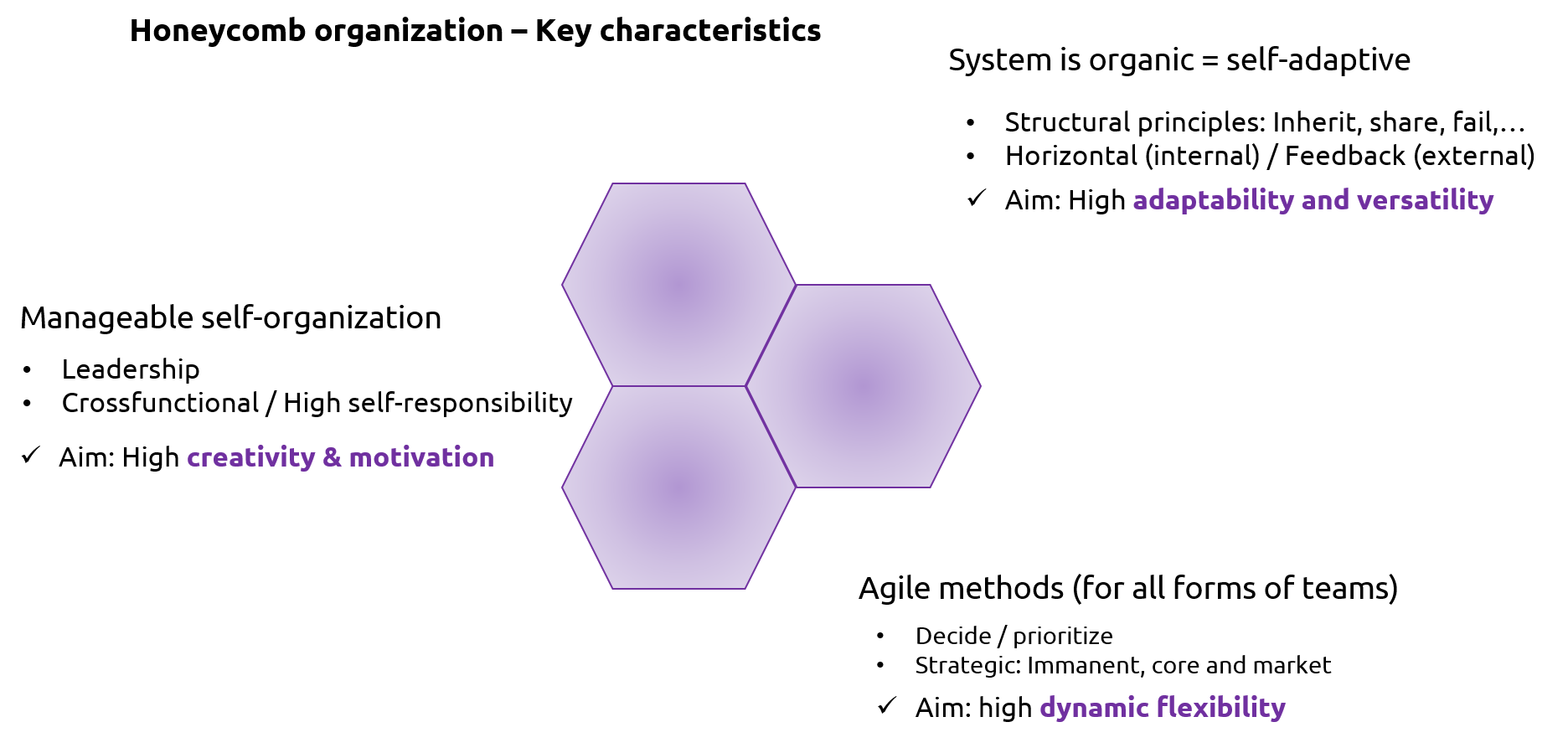Life always comes from a cell – one of the reasons why companies looking for a way to become faster and more efficient in their organizational structure take nature as a role model. The concept of an honeycomb organization can be quite successful – but how are cells, honeycombs and bees connected to successful companies and how to benefit from nature as a role model?
How do we survive in increasingly complex markets?
Why does every company and every organization, medium-sized businesses as well as global players, suddenly feel the need to be agile and innovative and to disrupt themselves?
Are we all chasing the buzzwords of digitalization? Without sense and reason? Not at all.
A single glance at our own customer landscape already shows the necessity of self-transformation. Purchasing behaviour is increasingly characterised by quick decisions. In times of Netflix and apps, people expect easy-to-use solutions that help directly and are ideally billed when they are actually used. This has an impact on the product lifecycle of established manufacturers, whether in the software sector or manufacturing industry.
A look to the left and right shows us parallel highly specialized providers that seem to jump-start and come up with exactly the solutions that customers need right now – and are therefore immensely successful.
But how do established companies manage to display precisely this drive, speed and customer focus in order to survive in increasingly complex markets in the future?
Hierarchies have had their day
The problem is often not a lack of competence, but unsuitable organisational structures that are no longer up to date. Those who want to continue to be successful are called upon to question their entire organisation, to become faster and to give employees more personal responsibility. Traditional hierarchies are facing difficulty in further development. But how can this change in the organization be implemented with as few frictional losses as possible?
On the way to an agile company
Whether with self-cleaning windows or agile organisation: it never hurts to take nature as a model.
There are many models that focus on personal responsibility in the company. The danger is that if everyone does what they want, anarchy will quickly prevail. The ideal is therefore a guided self-organization that gives employees responsibility, but still provides them with strategic guidelines within which they can become active. The comparison with the beehive, in which each employee has specific tasks, acts completely autonomously and yet always acts in the sense of the overall organization, is obvious here – and strictly speaking, the associated image of honeycombs that emerges before our mental eye is suited to concretize this actually abstract organizational system and make it tangible.
This blog article does not offer enough space to explain a complete “honeycomb organization” in detail. But it is sufficient to understand and internalize the most important core aspects. The possibility to act as a small team in a quasi closed area, so to speak as a start-up in a company, and to act completely independently in a “cell” of the organism has a lot of advantages – provided that the people in this cell really work independently. This means that they are always very close to the market, develop a solution themselves, validate it for relevance and scalability, and also take care of sales, marketing and their own internal processes in various task responsibilities. This guarantees permanent customer and market proximity, because the previous, often lengthy and inhibiting top-down decisions by the management are completely eliminated.
If you fail, fail fast!
“Boy, don’t make any mistakes! Or you’ll be out of business fast.” No! In an agile organization, everyone must be allowed to make mistakes. Because only those who are courageous and try something out can make a difference. It is important that these mistakes happen quickly so that we don’t have to work on new developments for two years, as is sometimes the case in traditional organizational structures, only to realize that the idea is completely missed by the market.
Those who fail quickly learn faster and can develop new innovations directly with new ideas. This is exactly how (successful) start-ups work. Only with the difference that a cell in the honeycomb organization always has the security of the core organization in the background. Thus, failure is easier and a distinct error culture is an elementary part of the guided self-organisation.
We call a combination of several cells “honeycomb”. And in order to avoid the anarchy scenario mentioned at the beginning, all cells within a honeycomb and beyond regularly coordinate themselves in prescribed procedures so that everyone always knows what the other one is doing. In this way, internal synergies can also be leveraged and at the same time external impulses can be collected, which often make a situation or challenge appear in a different light.

Sounds simple, doesn’t it? So why is change so difficult for many?
Innovation culture and change management – the human factor
The most difficult thing about organizational change is the change in mind. There are many tools and models to make organizations more agile. But in a company, first and foremost, people work. And anyone who believes that a fundamentally new organizational system based on personal responsibility can be hierarchically imposed from the top down has not understood the system itself. Employees must be fully involved as early as in the process of defining and designing the system and must be allowed to make the decisions that are later expected of them.
Without acceptance, the change of a company will never be successful. Only if a culture of innovation and employee participation is firmly anchored can digitalization be understood and implemented as an opportunity.
If you internalize this and inspire your employees for change by actively involving them in the development of the new organization, you are already well on the way. And always close to the market and fit for the future.
PS: Why honeycomb?
The organizational system presented above in its main features is the “Self-Adaptive-Organization-System” (SAOS) [More information: www.saos-consulting.de], a modern alternative to matrix, network and hierarchical structures, developed by the system consultant and author Andreas Lange. In the concrete progress of the project, however, this term usually falls victim to the much more catchy term “honeycomb orga” quite quickly.
d.velop AG is in the middle of the implementation of the honeycomb organization… We’re curious about the change process!

